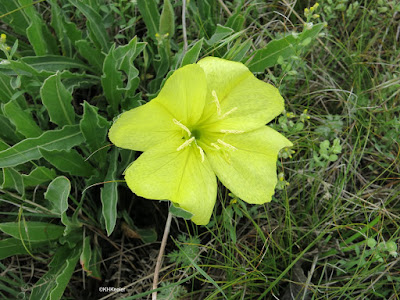 |
| Missouri eveing primrose Oenothera missouriensis in the grassland |
Apparently this group evolved and diversified relatively recently, spreading all over the Americas. Their classification--scientific names and relationships--has been unstable as DNA studies reveal that many evening primrose species look more like their cousins than their siblings: plants classified by flower and leaf features as A and B together and C and D together often are actually related A with C and B with D. Thus, lots of western plants called suncups, previously in the genus Oenothera, have been moved to the genus Camissonia, making it much bigger. At the same time, all the Gaura species, called bee blossoms or butterfly plants, are now species of Oenothera (see my blog on "scarlet guara" link). Since there are easily 144 species of Oenothera and Camissonia just in North America and only a few of them have been DNA-tested, there will probably be additional surprises. (Current status see Onagraceae website).
The family of evening primroses, the Onagraceae, is scattered around the world. Willow herb and fireweed (Epilobium and Chamaenerion) and the clarkias (genus Clarkia) from California are other members of the family.
 |
| evening primroses |
When botanists realized that both Onagra and Oenothera were plants of the same genus and wanted to put them into a single genus, they had to choose one name or the other. Oenothera won. Either it was older or more properly documented or both. All the Onagra species went into Oenothera: there are no longer any plants in the genus Onagra. By then, though, the scientific community was used to calling the evening primrose family the Onagraceae. The rule is that one of the genera (= plural of genus) in the family adds -ceae to its name to make the family name. With no Onagra species left, they might have made it Oenotheraceae--quite a mouthful--but agreed to keep the name Onagraceae. (That's what nom. cons. (nomen conservandum) means when you see it by a plant family, that, after discussion, this older name was kept.) So the family of evening primroses is named after a nonexistant plant genus.
 |
| evening primrose, likely common evening primrose Oenothera biennis |
 |
| evening primrose flower |
With a few exceptions the evening primroses are white or yellow. Many open their flowers in the evening to bloom during the night, pollinated by moths. Often in the morning they are attractive to bees and butterflies as well. My photos run to the yellow ones because they are more likely to be open when I arrive with my camera than the white, truly night-blooming ones.
As I said above, evening primroses are neither roses nor primroses and not closely related to either roses or primroses. Roses are the genus Rosa, in the rose family Rosaceae, with species native all over the world. Primroses are in the genus Primula, in the primrose family, Primulaceae, with species native from the Alps to mountainous Yunnan, China to the Rocky Mountains in North America. But one species, the common primrose, Primula vulgaris, was a showy early spring wildflower in Northern Europe. The common primrose is yellow. The evening primroses were discovered after colonization of North America and likely the first one seen was the common evening primrose.
So I imagine the names went like this:
Old England: "Those be roses."
 |
| roses, Rosa |
Prime meant first. The genus name reflects that Primula, "first."
Colonist: "Mercy, that wildflower looks like a primrose. But, how queer, the flowers only open at evening."
 |
| Evening primrose, Oenothera |
Now all three grow all over the English-speaking world, confusing people with their similar names.
 |
| another pretty evening primrose |
Comments and corrections welcome.
For more information, you might like my blog posts on:
Gaura coccinea now Oenothera suffructenscens link
Primroses (Primula) Reasons to like More reasons to like primrose color link
Plant families link
Kathy Keeler, A Wandering Botanist
More at awanderingbotanist.com
Join me on Facebook: https://www.facebook.com/AWanderingBotanist



Really enjoyed this taxonomic tour.
ReplyDeletelove your sense of humor that comes across. fascinating to read the history, thank you. I wonder if you can offer any insight into the indigenous native american name(s) for the common evening primrose?
ReplyDeleteI found this buried in an Italian book (19th century) on botany which as a google translation says the following, which may account for the donkey reference. I had a devil of a job finding out who Turneforzio was and I've added that info too: "Turneforzio (Joseph Pitton de Tournefort (1656–1708) French botanist) gave this name to OEnothera biennis, the alleged L.; resemblance of its leaves to the ears of the donkey being OENAS chimeric"
ReplyDelete